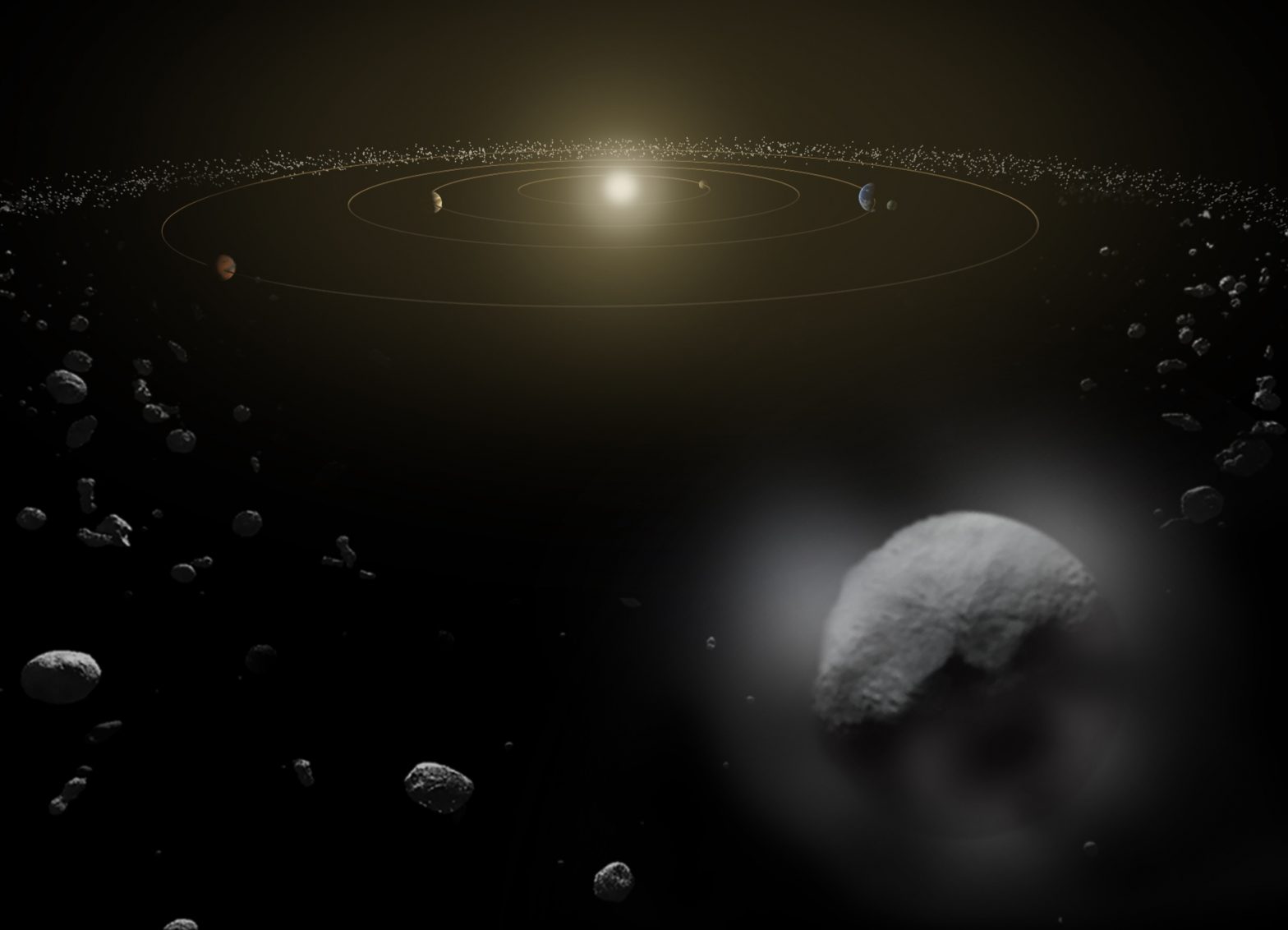As well as looking at very distant objects, Herschel’s instruments were used to look at planets, comets and asteroids in our own solar system.
When we look at a planet in visible light, we see sunlight that is reflected by the planet. But at the much longer wavelengths that Herschel observed, we will see thermal radiation emitted by the planet itself. The further away from the Sun, the colder the planet, as illustrated below.
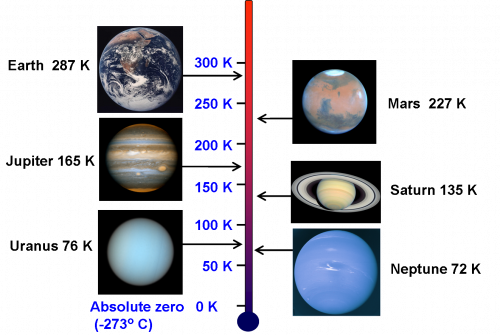
Herschel was not actually able to look at the inner planets, Venus and Mercury, because they are too close to the Sun and Herschel’s mirror must always be kept in the shadow of its sunshade, but all of the other planets, Jupiter, Saturn, Uranus, and Neptune will be studied. They have temperatures in the range 70 – 220 K, so that they do not glow in the visible region, but show up prominently at longer wavelengths.
Except for Jupiter, Herschel’s image quality, which is dictated by the wavelength and the size of the telescope, did not allow detailed pictures to be taken – Herschel looked at the whole disk of the planet at once. The diagram below shows the pixel size of Herschel at 200 microns wavelength compared with the apparent sizes of the planets.
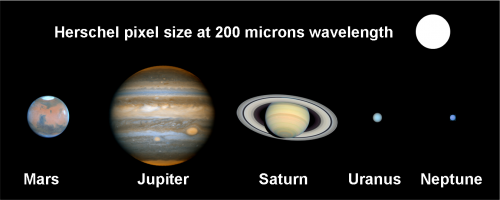
Mars: Some observations of Mars were made with PACS and SPIRE, but these instruments were so sensitive that Mars caused the detectors to be over-exposed – much like a video picture becoming saturated when looking at a very bright light. But the HIFI instrument was ideally suited to investigating the thin martian atmosphere, and it could detect the presence of molecules such as methane and water in the atmosphere.
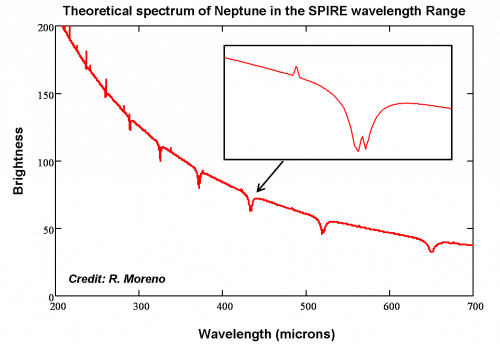
Uranus and Neptune: Emission from Uranus and Neptune at different wavelengths in the Herschel range comes from different levels in their atmospheres, so will be sensitive to properties such as temperature, pressure, and composition and how they vary with altitude. Tracing molecules at various altitudes provides information on how convection and winds move gases in the atmospheres – in other words, we can examine the weather deep inside the atmospheres of the giant planets. Gases like water, methane, carbon monoxide and ammonia are present and showed up through characteristic spectral features at particular wavelengths.
The diagram to the left shows a theoretical model of what the spectrum of Neptune looked like as observed by SPIRE. By comparing the actual observations with such models, we learned a lot about the structure and composition of Neptune’s atmosphere. Uranus was used as a standard “calibration” source by the SPIRE instrument – in other words, the brightness of other sources observed by SPIRE (galaxies, stars, comets, etc.) were measured by comparing them to Uranus. The reason for the choice of Uranus as the standard calibration source is that we already knew quite accurately how warm it is. It is a happy coincidence that it turns out to be the best choice, since Uranus was first discovered by William Herschel himself.
Comets: Comets are balls of dust, rock and ice left over from the formation of the solar system. By examining them we can learn about the raw material from which the Sun and the planets formed. Herschel looked at comets, detecting the thermal radiation from the nucleus and the spectral features of the gases that evaporate from the nucleus when the comet gets close to the Sun. Water is especially important to reconstruct the early development of the solar system, and determine whether comets were the source of water and pre-life chemicals on primitive Earth. It is another pleasing connection with the Herschel family that Caroline Herschel, sister of William, became famous herself as the discoverer of eight comets.
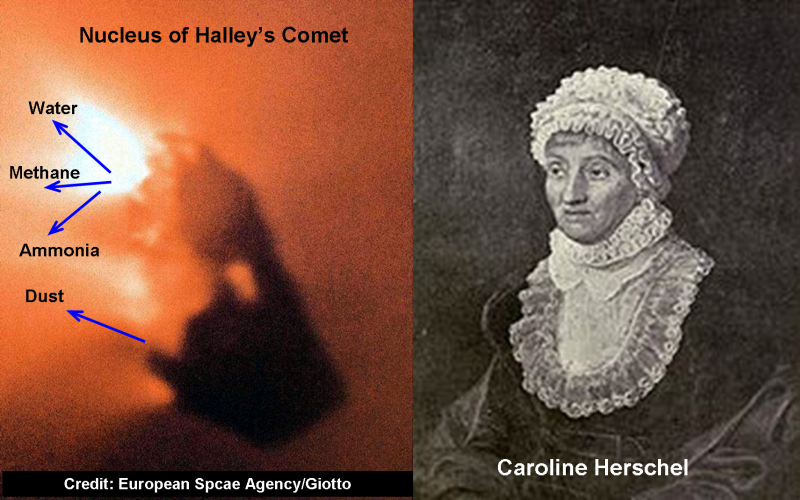
Asteroids and dwarf planets: Asteroids are lumps of rock left over from the early stages of the solar system. Most of the well-known asteroids are to be found between the orbits of Mars and Jupiter, but it has recently been discovered that there is a large population of asteroids much further out from the Sun, past the orbit of Neptune. These are so-called trans-Neptunian objects, about which we do not know very much, but we believe them to be remnants of the primitive planetesimal disk from which the solar system formed. Some of them are large enough to have been given the name “dwarf planets”. In fact, Pluto, previously categorised as a planet was recently relegated to the status of a dwarf planet. The pictures below show the location of the trans-Neptunian belt and the sizes of some known dwarf planets in comparison to that of the Earth.

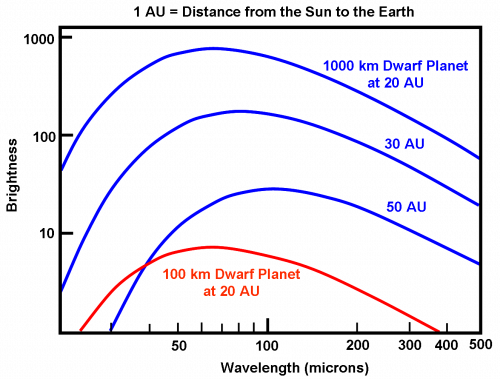
Because they are so far form the Sun, the trans-Neptunian asteroids and dwarf planets are very cold (about 40 degrees above absolute zero) – but that’s actually warm enough for them to emit light at Herschel wavelengths. The diagram to the left shows the expected thermal spectrum that Herschel could measure for dwarf planets of different sizes and distances from Earth.
By detecting these asteroids with Herschel, we were able to determine how big they are and what their surface rock is made of. In some cases, asteroids and dwarf planets are found orbiting each other, and by studying their motions the mass of the objects can be found. With Herschel measuring the size, the density could then be estimated, so that we could learn something about what the inside is made of.

